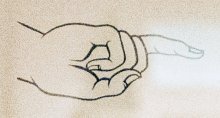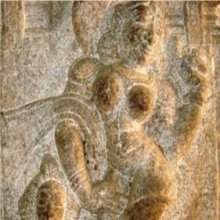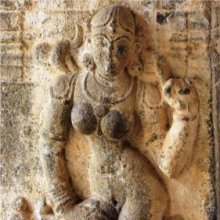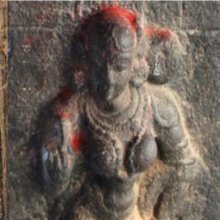Tarjani Mudra: 4 definitions
Introduction:
Tarjani Mudra means something in Hinduism, Sanskrit. If you want to know the exact meaning, history, etymology or English translation of this term then check out the descriptions on this page. Add your comment or reference to a book if you want to contribute to this summary article.
Images (photo gallery)
In Hinduism
Shilpashastra (iconography)
Source: Google Books: The Book of Hindu Imagery: Gods, Manifestations and Their MeaningTarjani(-mudra)—The raised index finger expresses a threat or warning.

Shilpashastra (शिल्पशास्त्र, śilpaśāstra) represents the ancient Indian science (shastra) of creative arts (shilpa) such as sculpture, iconography and painting. Closely related to Vastushastra (architecture), they often share the same literature.
Pancaratra (worship of Nārāyaṇa)
Source: SriMatham: Vaiṣṇava Iconology based on Pañcarātra ĀgamaTarjani Mudra (“The Gesture of Threat”):—This mudra is displayed by the guardian deities of the sanctum and serves to remind us to be restrained and to exercise respect and caution when entering into a sacred precinct.

Pancaratra (पाञ्चरात्र, pāñcarātra) represents a tradition of Hinduism where Narayana is revered and worshipped. Closeley related to Vaishnavism, the Pancaratra literature includes various Agamas and tantras incorporating many Vaishnava philosophies.
General definition (in Hinduism)
Source: Srimatham: Hindu IconologyTarjani Mudra — the gesture of vigilance — fist closed with the index finger raised. This mudra is usually found in images of protective or guardian deities and indicative of the need to be extremely mindful when approaching the spiritual path. The index finger is also representative of the ego which is the major obstacle to spiritual advancement. It also represents the principle of aggression and harm — aspects of personality which need to be overcome in the preparatory stages of spiritual life.
Source: Yogacheryl: HinduismHold hands open with palms facing center. Touch tips of index fingers together.
See also (Relevant definitions)
Relevant text
Search found 2 books and stories containing Tarjani Mudra; (plurals include: Tarjani Mudras). You can also click to the full overview containing English textual excerpts. Below are direct links for the most relevant articles:
Stupas in Orissa (Study) (by Meenakshi Chauley)
Emanations of Vairocana < [Chapter 5]
Drum slabs at at Ratnagiri < [Chapter 4]
Minor Votive Stupas at Ratnagiri < [Chapter 4]
The gods of northern Buddhism (by Alice Getty)



